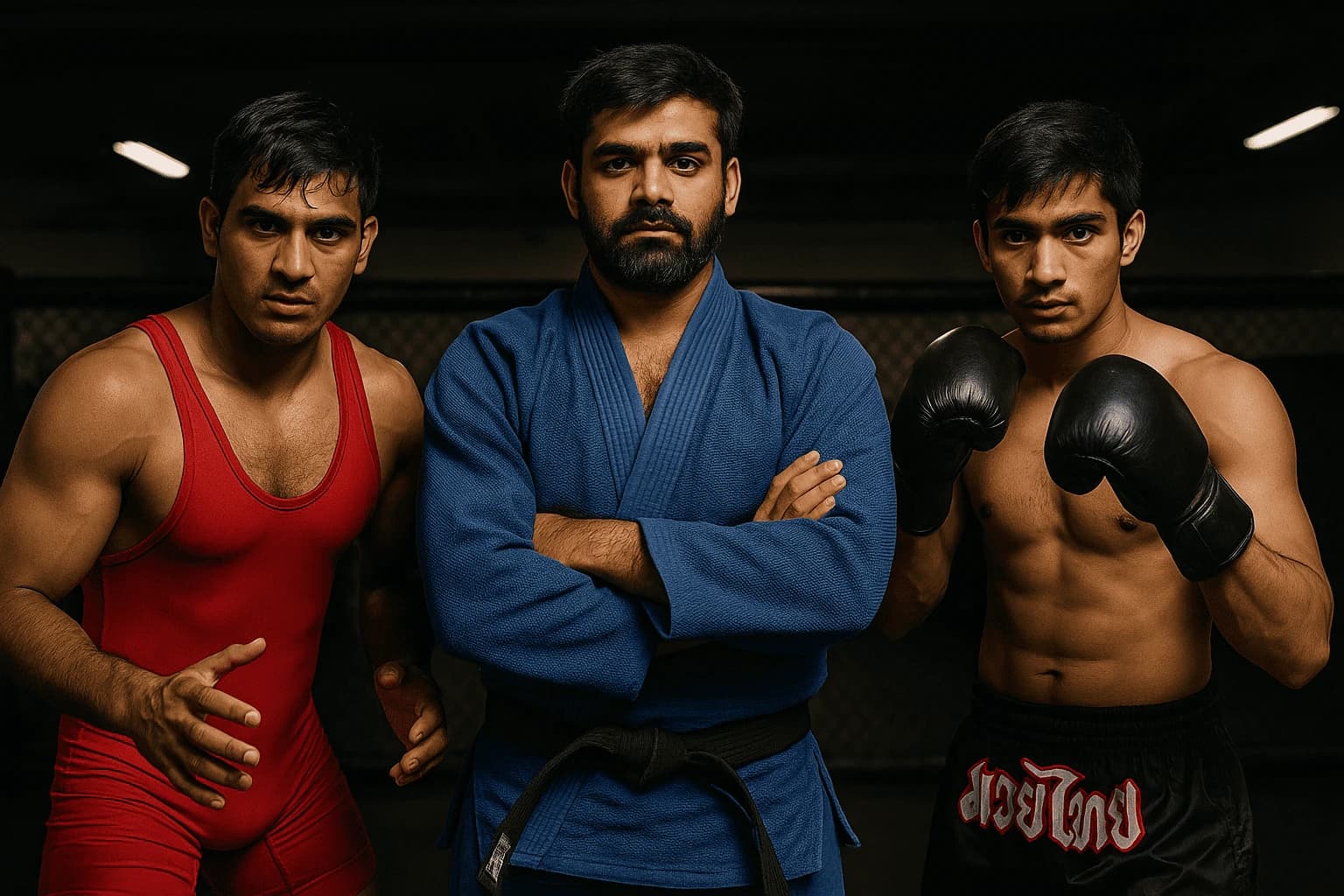© 2025 Info SportsbyTETRA SEVEN

* All product/brand names, logos, and trademarks are property of their respective owners.
Mixed Martial Arts (MMA) has exploded in popularity around the world, and South Asia is no exception. Countries like India, Pakistan, Bangladesh, Sri Lanka, and Nepal are producing fighters who are training harder than ever before. But what makes a good MMA fighter in South Asia? What skills are they mastering to survive in the cage?
Three main combat styles have become essential in the toolkit of a South Asian MMA fighter: Wrestling, Jiu-Jitsu, and Muay Thai. Each of these fighting styles brings something unique to the game. Together, they form a powerful combination that helps fighters compete not just locally but also on the international stage.
Let’s take a deep dive into how these three martial arts have become key pillars of MMA in South Asia.
Wrestling has been part of South Asian culture for thousands of years. Known locally as "kushti" or "pehlwani", this traditional form of wrestling was practiced in mud pits with strict discipline, diet, and training. Indian and Pakistani pehlwans were once global legends, winning medals and international fame.
Today, this ancient tradition is finding a new home in MMA.
Wrestling is the art of controlling your opponent. In MMA, this skill is important for:
Wrestling helps fighters set the tone of a fight. If you’re a good wrestler, you decide where the fight happens – on the ground or standing up.
Wrestlers from India and Pakistan are slowly crossing into MMA. Their strong base gives them an edge, especially in local fights where many competitors still lack strong takedown defense.
Some South Asian fighters start as wrestlers and then add striking or submissions to complete their skill set.
Brazilian Jiu-Jitsu (BJJ) is a martial art that emphasis on ground fighting, submissions, and chokes. It’s about using technique, leverage, and timing rather than brute strength.
In a BJJ fight, you don’t have to throw punches. You win by making your opponent tap out through joint locks (like arm bars) or chokeholds (like rear-naked chokes).
MMA fights often end up on the ground. Once there, Jiu-Jitsu is your best friend:
Many MMA champions, including legends like Khabib Nurmagomedov and Charles Oliveira, used BJJ to finish fights with technique.
In the last decade, BJJ has started growing in South Asia:
Most top-level South Asian MMA fighters now include BJJ in their training. Even if they don’t wear the traditional gi, they practice “no-gi” Jiu-Jitsu for MMA purposes.
Muay Thai comes from Thailand and is known as the "Art of Eight Limbs" because it uses:
Muay Thai is considered one of the most dangerous and effective striking arts in the world. It’s not just about punches – it’s about using your whole body as a weapon.
In MMA, striking is just as important as grappling. Muay Thai helps with:
A fighter with good Muay Thai can end a fight in seconds with a clean shot.
While Thailand is the homeland of Muay Thai, the sport has influenced the entire South Asian region:
Today, a complete South Asian MMA gym is likely to have a Muay Thai coach or striking program inspired by Thai techniques.
A typical modern MMA fighter in South Asia doesn’t just train one style – they mix it all. Let’s look at how their week might look:
The fighter’s body is trained like an athlete. The mind is sharpened like a chess player. They prepare for every situation – standing, clinching, or on the ground.
Every MMA fighter has a base – the style they’re best at. In South Asia, fighters often begin with one of the three:
The goal is to blend these styles. A pure wrestler will struggle if they can’t strike. A striker with no grappling can be taken down and submitted.
The most successful South Asian fighters are hybrids who’ve trained across all disciplines.
Let’s highlight a few examples of fighters who are making use of these styles:
These fighters are building well-rounded skills to compete with the best in Asia and beyond.
Training in Wrestling, Jiu-Jitsu, and Muay Thai is expensive and physically demanding. Here are some common challenges:
Despite these challenges, the passion is growing fast.
Many fighters are finding creative ways to master all three styles:
Even social media has become a tool. Fighters showcase their techniques, get feedback, and build connections globally.
The future looks bright for South Asian MMA. Here’s what we can expect:
Gyms that offer full MMA programs – wrestling, BJJ, and Muay Thai – are opening in major cities like Lahore, Mumbai, Dhaka, and Colombo.
More fighters are joining international promotions like ONE Championship, UFC, and BRAVE CF.
Countries are starting to recognize MMA officially and may support it like boxing or wrestling.
As local fighters succeed, they inspire the next generation. Kids now dream of being MMA stars.
South Asian MMA fighters are no longer just beginners. They’re warriors building their weapons carefully. Wrestling gives them control. Jiu-Jitsu gives them submissions and defense. Muay Thai gives them striking power.
Together, these styles form a complete fighting toolkit that can compete with the best in the world. South Asia’s fighters are still underdogs in many ways, but they’re training smarter, fighting harder, and dreaming bigger than ever.
And in the years to come, don’t be surprised if champions from Delhi, Karachi, or Dhaka step into the global spotlight – armed with takedowns, chokes, and crushing kicks.
No comments yet. Be the first to comment!